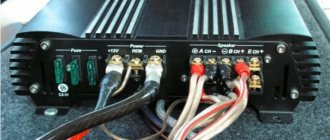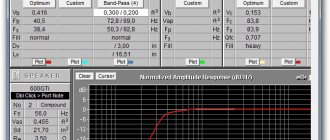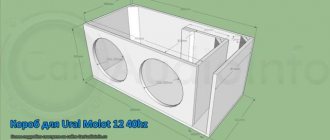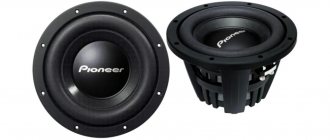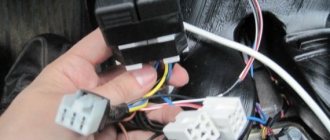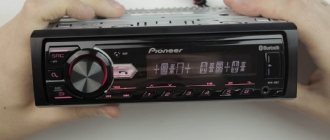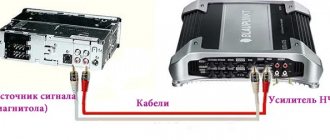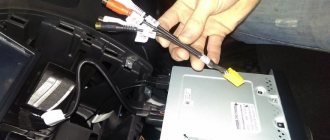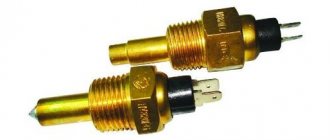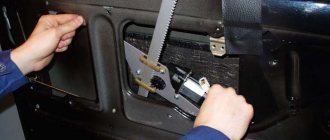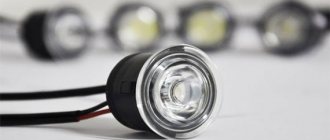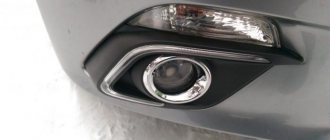For self-installation, it will be enough to purchase the necessary components and familiarize yourself with possible connection diagrams, and you can save on visiting a car service center. If a passive design is used, each of the system devices can be selected according to the specified characteristics. If it is necessary for the subwoofer and the radio to be turned on simultaneously, then use the corresponding positive wire. How to connect two subwoofers of 2 and 4 ohms. If your amplifier or active subwoofer does not have such an input, what should you do in this case? How to connect a subwoofer (series and parallel speaker connections)
The LPF knob is a low pass filter. Now you just need to see at what resistance your amplifier produces how many watts, and connect.
Then we pass the wires together with the power cable through the interior. If you have two similar speakers, you can simply connect them in series or parallel and get the desired impedance.
When connected in parallel, the resistance will be 1.3 Ohms, and when connected in series - 6 Ohms. Connecting two 2 Ohm subwoofers. Acoustic equipment in a car must be mounted conveniently and securely. On domestic cars it may be missing, as well as the hole itself.
Naturally, the resistance of the coils must correspond to the operating load of the amplifier in a bridge connection and the GAIN controls must be at the same level. Parallel and serial subwoofer connection
Connecting a subwoofer 2 X 2
Low-frequency systems with two loudspeakers are often installed in cars. They provide great power, deep and rich bass. The connection diagram for a 2 X 2 subwoofer may differ from other options. This design can be made in the form of a closed box or work with a bass reflex. Connecting a 2 X 2 subwoofer can be done in two simple ways. This is a series or parallel connection of loudspeaker voice coils. In order to calculate the resulting resistance, a simple formula is used. The voice coil winding is a low-resistance resistor. When two 2 Ohm coils are connected in series, the total resistance is 4 Ohms, based on the formula R total = R1 + R2 or 2 Ω + 2 Ω = 4 Ω.
The connection diagram for a 2 X 2 subwoofer at 4 Ohms does not cause any difficulties, since almost all low-frequency amplifiers operate with such a load. The formula for parallel connection of resistances looks a little different. Here the resulting resistance of several resistors will be less than the smallest resistance of the parallel circuit. According to the formula Rtotal=R1*R2/R1+R2, the resistance of two 2 Ω coils connected in parallel will be equal to 1 Ω. Connecting a 2 X 2 in 1 subwoofer is associated with some difficulties, since not all models of low-frequency amplifiers can work correctly with such a load impedance. Each connection has its own specifics. If in the subwoofer connection diagram there are 2 X 2, the windings of the voice coils are connected in series, then the power will decrease by about half. Since one speaker with an impedance of 2 provides a nominal power of 500 watts, connecting a second speaker in parallel with the same impedance will reduce the system output power to 350 watts.
Connecting two car amplifiers
Well, let's all go in order: 1 What is a 2-channel amplifier. Ready-made sets of interconnect wires always include a control cable. A fuse is installed along the power circuit to protect against short circuits and possible overloads. Some people connect subs to class D amplifiers in series. Let's move on to the next point directly to the connection diagrams. Now we have come to the final stage, after connecting, we need to configure the 2-channel amplifier with the adjustment controls. Well, let's all go in order: 1 What is a 2-channel amplifier. Do not forget to check at what resistance the amplifier provides such power. His role is as follows. One of the advantages of an active filter is the ability to fine-tune frequency cuts. A two-coil subwoofer, as well as two, three or more subwoofers, can be connected in four ways: each coil separately, parallel connection of coils, serial and combined. An option would be a high-level adapter, which is a signal level converter. connecting an amplifier to a subwoofer
How to connect a 1 ohm subwoofer
The subwoofer connection diagram in 1 ensures maximum power from the low-frequency unit and the highest volume level. However, the quality of bass reproduction will not be the best. Low frequencies will be “smeared out”. As the load resistance of the amplifier increases, the power will decrease, but the quality of low-frequency reproduction will noticeably increase. The blurriness of the sound will disappear, and the bass will become clear and deep. You cannot connect a 1 Ω subwoofer to every amplifier model. The description of some low-frequency units specifically stipulates the minimum permissible load resistance. Loudspeakers with a 1 Ω coil are rare, so this resistance is usually obtained by connecting two 2 speakers in parallel. Connecting a 2 X 2 in 1 Ohm subwoofer can be done by using one speaker with two 2 Ω windings. They always indicate the polarity. In order for the speaker system to work correctly, you need to connect the speaker contacts correctly.
The pros and cons of the voice coils are interconnected and connected to the corresponding contacts of the low-frequency amplifier.
How to connect a 4 ohm sub
Connecting a subwoofer at 4 is considered the most common, since most dynamic heads have such resistance, and all types of low-frequency amplifiers allow the use of such speakers as a load. You can organize a 4 ohm load using two 2 ohm speakers connected in series, when the plus of one speaker is connected to the minus of the other. The connection diagram for a subwoofer in 4 can be obtained using a two-winding speaker. Depending on their resistance, the connection configuration depends. Two coils of 8 connected in parallel will give, as a result, the required 4 Ohms. The same resistance is obtained if two voice coils with a resistance of 2 ohms are connected in series.
In the connection diagram for a subwoofer in 4, the minus of one voice coil is connected to the plus of the other winding, and the remaining free contacts are connected to the output of the low-frequency amplifier, observing polarity. Connecting two subwoofers of 4 is carried out in parallel or in series. Connecting a subwoofer 4 4 in 2 will provide increased power almost twice. The series resistance of the windings will be 8 Ω. The power will be reduced, but the bass performance will be bright and clear.
How to connect a two-coil subwoofer
Connection diagrams for a two-coil subwoofer are limited to the following several options:
- Parallel connection
- Serial connection
- Separate connection
Most often, the resistance of the windings of low-frequency speakers is 2 or 4 ohms. With a parallel connection, the total resistance will be half the resistance of each winding. It will be 1 or 2 respectively. A series connection will give a resistance of 4 or 8 Ω. By reducing the output power, the best sound quality is achieved at low frequencies. In addition, you can connect a subwoofer with two coils without connecting them, but by using each winding for a separate channel of the low-frequency amplifier. Connecting 2 coil subwoofers must be done with strict observance of polarity. It would be undesirable for an amplifier to connect a 2 Ohm subwoofer in a bridge connection.
Each amplifier channel will operate at 1 Ω, and this is a dangerous load for some models of low-frequency equipment. The power will increase, but at the same time the current will increase and nonlinear distortion will increase. The ULF output stages will operate in a critical mode and may fail. Separate connections are allowed only if absolutely the same signal is supplied to both channels of the amplifier.
How to connect a 2 to 2 sub
The connection diagram for a 2 Ohm subwoofer is carried out according to the classical scheme, when the speaker coil is connected to a low-frequency amplifier. It is better to connect a 2 Ω subwoofer, consisting of one loudspeaker, to a separate ULF channel, since when bridged, the low resistance of the coil can damage the system. In addition to a subwoofer with one speaker, a system of two separate 2 Ohm loudspeakers or a two-winding dynamic head can be used as a ULF load. By combining the connection of the voice coils you can connect a 2 2 in 4 ohm subwoofer. To do this, they need to be connected in series. Connecting 2 x subwoofers 2 2 is carried out with a large-section multi-core acoustic cable to avoid power losses due to heating of the connections. In order to connect two 1 ohm subwoofers, the 2 ohm voice coils must be connected in parallel.
Connecting interconnect wires and control (REM)
To lay the cable, you need to find the linear output on the radio. The linear output can be recognized by the characteristic “bells” that are located on the rear panel of the radio. The number of linear outputs differs in different radio models. Usually there are from one to three pairs. Basically they are distributed as follows: 1 pair - you can connect a subwoofer or 2 speakers (labeled as SWF) If there are 2 pairs of them, you can connect 4 speakers or a subwoofer and 2 speakers (outputs are labeled F and SW), and when there are 3 pairs of linear wires on the radio, you can connect 4 speakers and a subwoofer (F, R, SW) F This is Front i.e. front speakers, R Read rear speakers, and SW Sabwoorer I think it’s clear to everyone what that is.
The connection will require an interconnect wire, which should never be skimped on. It is prohibited to lay the interconnect cable near the power wires, as various types of noise will be heard when the engine is running. You can run the wires both under the floor mats and under the ceiling. The latter option is especially relevant for modern cars, in the interior of which there are electronic accessories that create interference.
Subwoofer connection 1 1
The 1 Ohm subwoofer connection circuit is not used often, since, despite the high output power, this mode does not provide good quality reproduction of low frequencies. Some models of low-frequency car amplifiers do not allow the connection of such a small load at all. Connecting two 1 Ohm subwoofers is only allowed when the windings are connected in series. A resistance of 0.5 Ω, which is obtained with a parallel connection, can destroy the amplifier. A bridge switching circuit will reduce this value by another factor of two. When connecting a 1 Ohm subwoofer, you need to remember that as the resistance decreases, the current increases, so all connecting cables must have the appropriate cross-section. Do not use single-core wires or cables intended for electrical wiring to connect high-power speaker systems.
Problems you may encounter when connecting
The following difficulties may occur when connecting the device:
- A factory car radio usually does not have a special audio connector for an amplifier - this can be solved by purchasing a special adapter;
- Setting and correlation of low and high frequencies with the main acoustics of the car.
Please note: to properly connect the subwoofer to the car radio, you must have basic knowledge of electrical engineering. Otherwise, it is better to contact a car service center for specialist help.
Source: autovogdenie.ru
How to connect two subwoofers to one monoblock
An acoustic low-frequency system can consist of one or two speakers. Columns in which a larger number of loudspeakers are installed are used extremely rarely due to their large dimensions. The following amplification systems can be used to organize a low-frequency channel:
- Monoblock
- Two channel amplifier
- Four-channel ULF
A monoblock is a separate amplifier that works only on the low-frequency channel. The connection diagram for two subwoofers to a monoblock depends on the resistance of the voice coil winding. If it is equal to 4 Ohms, then both parallel and series connections of windings are allowed. As a result, the total resistance of the speaker system can be 2 Ohms or 8 Ohms. Connecting a subwoofer 8 Provides the highest quality bass reproduction with a minimum of non-linear distortion. This configuration is the safest for a low-frequency unit, since the currents in the amplifier circuits will be small and the elements of the output stages will not overheat. You can connect 2 subwoofers with speakers of 2 Ohms each to the monoblock. In this option, only a serial connection is allowed if the car uses an AB class amplifier. If the basis of the low-frequency system is ULF class D, then parallel connection of loudspeakers with a total resistance of 1 ohm is allowed.
In addition to speaker systems with two speakers, speakers with two windings are often used in low-frequency channels. Typically, such heads have a winding resistance of 2, 4 or 8 ohms. You can connect a two-coil subwoofer to a monoblock, as well as separate speakers, in several ways. Since there are two coils, their separate connection to the monoblock is impossible. To do this, you need to use a two-channel or four-channel amplifier. The connection diagram for a 2 X 2 Omak monoblock subwoofer allows parallel connection of windings for ULF class D and only serial connection for other classes of amplifier equipment. The most common mistake when connecting a 2 X 2 sub is using only one winding. Some people believe that there is only one channel in a monoblock and it is enough to connect only one winding. Testing of speakers with two coils and different connection schemes showed that when only one coil is connected to the output of a low-frequency amplifier, the sensitivity of the speaker system decreases by approximately 3 dB. Therefore, you can connect a subwoofer to a monoblock only by connecting both windings.
Car subwoofer: types and design features
A subwoofer (SBV) is an acoustic system that converts low-frequency sound waves.
You don't need it to listen to most music tracks. A sub is needed for high-quality sound of low frequencies (bass).
Subwoofers come in two types:
- Active - they already have a built-in power amplifier;
- Passive - there is no amplifier and requires additional connection so that the output sound is clear without distortion or interference.
A passive subwoofer may look like a regular large speaker or a box in which the speaker is placed.
Structurally, an active sub consists of the following elements:
- body - wooden or plastic;
- woofer;
- signal regulator;
- amplifier;
- signal frequency regulator.
For high-quality sound, the active sub must be correctly connected to the radio.
Types of subwoofers by design:
- Horn - the type has a folded horn-speaker, used at concerts;
- Closed - is a speaker installed inside and tightly adjacent to the walls of a closed box;
- Bass inverter - a type using a ventilation pipe, from which, under the force of sound waves, air comes out along with low-frequency sound;
- Quarter-wave resonator - acoustics with a tunnel design, a tunnel-pipe, of a given length and cross-sectional size through which sound comes out;
- Bendpass is a box with a bass inverter, divided in the middle by a wall into two chambers, different in volume, the speaker is placed in the partition between them.
Connecting the subwoofer to the radio
It is necessary to connect the subwoofer to the radio only through an amplifier. Since the built-in power of the radio is not enough for the subwoofer to work properly, you will not get normal bass. The connection chain is simple: radio-amplifier-subwoofer. The radio transmits the signal to the amplifier. The amplifier, in turn, amplifies this signal and sends it to the subwoofer.
What is an amplifier for?
The amplifier is used to increase the volume headroom, reduce distortion and improve the sound quality of music. The built-in amplifier of the radio is not enough to drive a heavy low-frequency speaker, which will cause large distortions, the volume level will be low and, with a high probability, the subwoofer may fail or simply “burn out.”
If you have an active subwoofer, then you will not need an additional amplifier, because it is already built into the subwoofer housing (more about active subwoofers). For a passive subwoofer you will have to choose an amplifier (read how to do this correctly on this page).
Good nutrition is the key to success
The amplifier connection procedure begins with the power wires. Wiring is the most important element of a car audio system; the volume and sound quality depend on it. Amplifiers need a stable power supply, otherwise the power will not be enough and the sound will become distorted. To understand why you need to pay attention to the quality of wiring and how it affects the sound reproduced by a loudspeaker, you need to know what a music signal is.
Some suggest that it represents a sine wave, however, the musical sinhala is characterized by a large difference between the normal and peak value. If sharp signal bursts are not important for car speakers, then in the case of an amplifier the situation is completely different. If the signal exceeds the permissible power for even a second (or even a millisecond), then these “anomalies” will be audible even to those who cannot boast of a good ear for music.
How to connect a subwoofer to an amplifier
Single channel connection
Connecting a subwoofer to an amplifier is not difficult; just connect the amplifier's audio output jack to the subwoofer coil or coils using speaker wires.
The wires should not be thin. In most cases, choose copper wiring with a cross-section of 4 mm and there will be no problems.
Connecting speaker wires
This subwoofer connection diagram is suitable for one channel of an amplifier or monoblock.
Monoblock is a single-channel amplifier designed specifically for subwoofers.
Connecting to a subwoofer via terminal block
Connecting to a subwoofer directly
Connecting a subwoofer with a bridge
In the case of using a multi-channel amplifier, the sub can be connected to two channels simultaneously, using the minus of one and the plus of the other, this connection is called bridged, with this method the power output by the amplifier increases significantly (see the specifications for specific numbers).
So you can connect a subwoofer to a two or four channel amplifier, using 2 channels for acoustics, and the remaining 2 for the subwoofer.
To connect a subwoofer with a bridge, make sure that your amplifier supports this feature.
If you connect a low-frequency speaker to an amplifier by changing the polarity, that is, connect the plus of the subwoofer to the minus of the amplifier output and vice versa, then the speaker will work in antiphase, there is nothing wrong with that, sometimes such a connection is used intentionally if the amplifier does not have phase adjustment (more about adjustment phases).
Connecting the subwoofer coils
The technical documentation for the subwoofer states the resistance of its coils (1 Ohm, 2 Ohm, 4 Ohm, rarely 0.5 Ohm), and the technical documentation for the amplifier indicates what resistance it can work with, this information is needed so that you connect correctly and effectively subwoofer to amplifier. The lower the resistance of the sub, the more power the amplifier will produce, provided that it can operate at this resistance. A subwoofer speaker may have several coils (1 or 2, rarely 4).
When the coils are connected in series, the resistance increases, while in parallel it decreases. If you don't want to learn definitions and count fractions, just save this cheat sheet (parallel and serial connections).
How much ohm to connect the subwoofer
The higher the resistance, the better the sound quality; the lower, the more power the amplifier delivers. If you need a lot of loud bass, then turn it to the minimum that the amplifier can provide, and if the overall sound quality of the system comes first, then it is 2 Ohms or 4 Ohms, depending on the power output.
Video on how to connect 2 subwoofers or more. Subwoofer connection diagram 2x2 Ohm, 4x4 Ohm, 1x1 Ohm. Serial connection of speakers. Parallel connection of speakers. Basic principles.
Happy connections!
Forum "Auto-HiFi"
Is it possible to connect 2 different subwoofers with approximately the same rating to 1 monoblock?
| Message | Creator |
| 2013-09-17 14:48:55 Alexey7 Inhabitant Address: Moscow Posts: 44 | |
| No. two similar ones in one box. and so it will be shit, one own sound gives another own one. It's like two housewives in the kitchen! Yes. and with something you will power your own amplifier. what power wires are there? | 2013-09-17 15:11:10 Gestapo666 Inhabitant Address: Nizhny Novgorod Posts: 54 |
| The question is not what kind of sound there will be, but whether it is possible to connect absolutely 2 subwoofers to a monoblock? power Kg-25 | 2013-09-17 15:18:05 Alexey7 Inhabitant Address: Moscow Posts: 44 |
| what subs. one reel or 2. what kind of monoblock? nominated subs. what manufacturer? And the wires. yours are welding wires, not for car audio! The kg cable is designed to supply welding current from the machine to the welding site. Don’t do crap. You live in Moscow; the availability of good components for car audio is enormous. and you are assembling a system from welding things that are not intended for sound! This is exactly the same as using a sub as an ordinary speaker or even worse - as a tventer! Minimum 2Ga mid wires – the best option (cost-quality) Premier! Or better yet, Duxx, Stinger. Sundown Audio! | 2013-09-17 16:16:40 Gestapo666 Inhabitant Address: Nizhny Novgorod Posts: 54 |
| But what difference does it make what wires power the amplifier, the thicker the better. Now, if the wires are from the amplifier to the speaker, then yes, the wires matter. For me, even laying a solid busbar from a transformer to power the amplifier, there will be absolutely no losses. IMHO, regarding subs, open the annotation for the speakers and look at the connection diagram, all possible options should be demonstrated there | 2013-09-17 17:18:14 viktor41 Inhabitant Address: Volsk Posts: 39 |
| you just need to know the resulting total resistance. For a monoblock not lower than 1 Ohm. And it’s possible, why not? At least you can hang a garland of subs, since the question of the playback property is not interesting. KG is a good cable. | 2013-09-17 20:56:51 Kif Newbie Address: Yelets Posts: 2648 |
| What if you connect 2 similar MTX RT12-04 box subwoofers? It’s just that I already have one, I’d like to take another one of the same kind, in the same used case. It will work at 2 Ohms, just a 500W monoblock produces at 2 Ohms. How is this a solution? I think it will be fine, because I saw that they make 2 stealth units in the trunks in different niches, it turns out that any sub works in its own similar volume. Otherwise, it’s wasted and I don’t want to redo everything all over again. I don’t want FI, I like ZY more. | 2019-07-27 07:44:58 Xard Newbie Address: Moscow Posts: 21 |
How to connect a single-channel amplifier (subwoofer monoblock)
Single-channel car amplifiers are designed for one purpose - to work with a subwoofer. Such amplifiers have increased power and the ability to operate with low-impedance loads.
What is a low-impedance load - the normal resistance of car speakers is 4 Ohms, everything that has a lower resistance (3 Ohms, 2 Ohms, 1 Ohms) is called a low-impedance load.
These are often class D amplifiers. Almost all single-channel amplifiers have a built-in LPF filter (cuts off all frequencies above the filter setting frequency), a 0-180° polarity (phase) switch, a “subsonic” filter - cutting off audio frequencies below 10-15Hz, as well as a regulator subwoofer level. Connection diagrams for single-channel amplifiers are simple. You can connect one or more subwoofers, in parallel or in series. Subwoofers reproduce a monophonic signal - the stereo signal from the head unit is summed in an amplifier.
Here is the simplest and most common subwoofer connection diagram . The low-level stereo signal (linear) from the radio goes to the amplifier, is summed, amplified, and the subwoofer reproduces a monaural signal. One subwoofer has a resistance of 4 ohms. Everything is very simple. (Blue indicates interconnect cables, green indicates acoustic cables).
Here's how to connect subwoofers (and any other speakers) in parallel :
In this way, you can connect not only two but also more subwoofers, the main thing is that the amplifier can cope with the load resistance. The formula for calculating resistance looks like this:
In our case, when connecting two subwoofers in parallel with a resistance of 4 Ohms, each we get a total resistance of 2 Ohms. Most subwoofer amplifiers are designed to handle this load.
The advantage of this connection is that the amplifier develops higher power with a low-impedance load (check the instructions for your amplifier!). The downside is that the sound quality deteriorates - the bass loses control and becomes washed out. Amplifiers operating with low-impedance loads heat up more. You have to pay for everything!
When subwoofers are connected in series, the impedance adds up. Here is an example of connecting two 4 Ohm subwoofers in series:
The formula for calculating the resistance in this case is the simplest - we simply add up the resistances of all speakers:
With this connection, the sound quality improves, and the power developed by the amplifier decreases. Look for a compromise.
Now let's talk about filters . The most important filter in a subwoofer amplifier is the LPF (or low-pass filter). This filter (simplified) passes all frequencies below the frequency to which it is tuned and cuts off everything above.
Thus, our subwoofer reproduces only the lowest bass, as it should. If your subwoofer is in the trunk, we recommend not raising the cutoff frequency above 70Hz so that the bass is not localized at the rear. The LPF filter is adjusted experimentally until the sound of the subwoofer and midbass is harmonious, and this is a whole science and luck
The subsonic filter is an infra-low-pass filter. Good subwoofer amplifiers always have such a filter.
It is recommended to always turn on the subsonic if you have a subwoofer in a bass reflex or free air enclosure. This is not necessary for a closed box.
Some amplifiers (mostly cheap and mid-priced) have a so-called “ Bass Boost ” - an equalizer that adds bass at low frequencies. We recommend using it only in extreme cases or not using it at all. Using bass boost results in increased distortion and can even lead to speaker failure due to overload.
The same applies to loudness on the radio (LOUD function). Turn it off - if you already have a subwoofer, then you have no use for it.
Read our other articles to understand:
see also
Comments 72
Is it possible to connect CT 12 (2+2) at 2 Ohms to Zeus 1.1000 (has 2 pairs of terminals, but it is not known whether they are duplicated or independent)? Thank you
Hello guys everyone. Can you give me some advice too? Amplifier kick rts 4.60 (4 ohm) sub oris two pancakes (1 ohm) two coils. How can I connect a sub so that it hits 4 ohms? Four fronts are connected to the same front. Maybe it’s easier to install an additional amp or wire up the sub itself? I hope I described it in as much detail as possible
Where do you get the plus minus when connecting 3 subs with one coil?
And so the question is, I didn’t find a diagram for myself, the sub is a custom former def bonus 123, the coils have been converted to 0.5+0.5 ohm resistance, the m2000d monoblock machete, how to connect it to 1 ohm? A diagram, at least in words. I would be very happy, I’m afraid I’ll burn it, it’s a little expensive.
There is a two-reel Mystery MO12S sub and a monoblock MR1.300, also a Mystery. What is the circuit for it so that it works from a 2 ohm amplifier? If I understand correctly, then according to scheme 10?
author, of course I’m sorry, but parallel switching of one subwoofer with two 4 ohm coils, wouldn’t it be 1 ohm? After all, they divide, that is, it turns out 4_4 = 1 Ohm. Or am I wrong?
Not right. With series -4+4=8 Ohms With parallel - 1/R total R total= 1/4+1/4, therefore 1/(1/4+1/4) = 1/0.5=2 Ohms. Everything is simple, if there is 1 sub with 4 ohm coils it is only either in 8 or 2, if it is 2 ohms - in 4 or 1 ohm.
blah, Thank you, now everything has fallen into place. I felt ashamed, I was trained as an electrician and didn’t understand how to connect the coils. PPC
bookmarked)))useful, but... I’m a beginner sound engineer, so I have a question. How will it be correct to connect the alphard machete m15d2 (coils 2+2) to the Kixar 1.350 (2 Ohm: 600 W x 1, 4 Ohm: 350 W x 1)?
I will be very grateful for your answer)))
How to connect a sub with a double coil 4+4 in 4 Ohm using both coils?
Greetings, please tell me if I understood correctly how to connect the sub, the monoblock amplifier has 4 terminals - 2 plus, 2 minus, on the sub there are 2 coils of 2 ohms. I connect one plus and minus from the amp to one coil of the subwoofer, the second plus and minus to the second coil and it turns out to be connected in 1 ohm?
Please tell me. How to connect in 1st? Sub Ural Armada 2+2 coils.
one sub 2+2 and 4 channels, will there be any losses when connecting?
Hello everyone, please tell me how to connect 3 subwoofers with 4+4 coils, and how many ohms will be the result?
Hello. Is it possible to connect a 2-channel amplifier with one channel to the sub and the other to the rear speakers?
Maybe. But here is another question: the power of one channel for driving the subwoofer is negligible and the remaining one channel to the rear will be MONO. There is no point in such a connection at all.
Hi all. Tell me sub macheta 15d4. Two coils 4+4 Ohm. how to connect it to a monoblock for stronger pressure. I haven't purchased a monoblock yet. And what kind of candy bar can be connected to it (budget)
Circuit #12 Will work at 2 ohms.
Guys, I have an Alphard Hannibal SD 152 and a Kicx AR 1.350, you can feed it in 1, 2, and 4 and nothing will happen to it, as I understand it? So the sub is rated at 350W, when connected in the 4th ohm it gives 350W, and in the 1st ohm it gives 1000W, and the sub has a peak of 1000W. If I connect it in the 1st ohm, can it be covered? And what is the best way to connect it?
I don’t understand something, should I answer or what?
I don't know what to answer. there will be no pressure in the 8th. in your case, the most successful connection is through a monoblock at 2 ohms. It is much easier to burn a sub with a lack of power than with too much power. What you wrote is that you are trying to make a system not according to your mind, but to cobble together it from what is available. Nothing will come of this traveler's approach. There are amplifications that are not designed for 2 ohms, but in practice I feel very good at 2 ohms. for example kick cap 29.
Well, it would be like that right away, thanks for the answer, but it’s over, I knew it, just as you said, I wanted to create something from what I had, at least it would be a little bit of use from what I wrote if there was a stupid 2 ohm resistor to 2 ohms for screwing up? I’m interested in this... this is for the sake of an experiment for a while, then I’ll take the sub at 4 ohms exactly
theoretically it will work. but I don’t know how it will work in practice. I've never tried to connect like this. Here, only through experimentation will it be possible to find out anything.
I understand, it’s just damn it and I can’t really google exactly my question, it turns out that it’s not at all what I need))
I would still try to connect it to two channels at 2 ohms. Quite often it works fine. But the possibility of burning the amplifier still remains.
I have a 2-channel weak 60-watt nominal, but I have a 4-channel which with a 2-ohm bridge will produce about 600 watts nominal, they write on the internet that it seems like I can handle it, and even if something happens, it should go into defense
I am tormented by a question, I have a 4+4 ohm two-coil din, that is, I can either use 8 ohms or 2 ohms, can I connect it to 2 ohms plus through a 2 ohm resistor to get 4 ohms resistance? Will there be any pressure more than 8 ohms with such a circuit? I’m asking this because I’m afraid to burn out the sub in 2ohm, and the bridge I sat on is not intended to play in 2ohm.
1 sub coil 1+1 how to connect it in 2 ohm?
sequentially: minus and plus among themselves, others minus and plus to the amplifier
hi, is it that it turns out that one coil will just work? I don’t understand? Can you draw a diagram on a piece of paper that is clearer?
Look at diagram No. 4 and connect it the same way.
Already done, thanks for responding buddy!
hi, is it that it turns out that one coil will just work? I don’t understand? Can you draw a diagram on a piece of paper that is clearer?
or according to scheme No. 9
added to bookmarks)
Please tell me a diagram of how to connect two subwoofers, but the only problem is that they have different resistances. one has 2x4 ohms and the second has 2x2 ohms. Is it possible to connect in 1 Ohm?
tell me what the difference is if one sub with two 4 ohm coils plays at 8 ohm or at 2 ohm, what will be the difference?
By sound: In the 8th. will play very clearly, but there will be little pressure... in the 2nd. vice versa.
and as I understand it, at 8 ohms the sub will live longer
Tell me how to use a 4-ohm nick and two low-power 8 ohm nicks so that they work separately, that is, either one 4 ohm or two 8 ohm mics
In order to connect three dins with two coils of 2 ohms at 1.33 ohms, do you need to set the minus to one, and the plus to three? Did I understand everything correctly?
Very understandable, but I can’t find mine, can you help? Here I have one sub with 2 coils of 4 ohms, in the amplifier in the bridge there are 4 ohms, therefore I can connect one coil to the amplifier bridge and that’s it, and the second coil will be empty, right? Will the equipment be damaged?
2 coils of 4 ohms can be connected to 2 ohms or 8 ohms. If the amplifier does not support operation in 2 ohms, then you can only connect it in 8 ohms, but with such a connection, most likely the amplifier will not have enough power. in your case, it is better to buy a monoblock that will work stably at 2 ohms.
Yes, it will definitely be bought for the New Year! But now I'm afraid to check it. what if I just connect one coil to the bridge? what will happen? In my opinion, if I make 8 ohms out of 2 coils, the amplifier will simply burn out!
Forum "Auto-HiFi"
Is it possible to connect 2 different subwoofers with approximately the same rating to 1 monoblock?
| Message | Creator |
| 2013-09-17 14:48:55 Alexey7 Inhabitant Address: Moscow Posts: 44 | |
| No. two similar ones in one box. and so it will be shit, one own sound gives another own one. It's like two housewives in the kitchen! Yes. and with something you will power your own amplifier. what power wires are there? | 2013-09-17 15:11:10 Gestapo666 Inhabitant Address: Nizhny Novgorod Posts: 54 |
| The question is not what kind of sound there will be, but whether it is possible to connect absolutely 2 subwoofers to a monoblock? power Kg-25 | 2013-09-17 15:18:05 Alexey7 Inhabitant Address: Moscow Posts: 44 |
| what subs. one reel or 2. what kind of monoblock? nominated subs. what manufacturer? And the wires. yours are welding wires, not for car audio! The kg cable is designed to supply welding current from the machine to the welding site. Don’t do crap. You live in Moscow; the availability of good components for car audio is enormous. and you are assembling a system from welding things that are not intended for sound! This is exactly the same as using a sub as an ordinary speaker or even worse - as a tventer! Minimum 2Ga mid wires – the best option (cost-quality) Premier! Or better yet, Duxx, Stinger. Sundown Audio! | 2013-09-17 16:16:40 Gestapo666 Inhabitant Address: Nizhny Novgorod Posts: 54 |
| But what difference does it make what wires power the amplifier, the thicker the better. Now, if the wires are from the amplifier to the speaker, then yes, the wires matter. For me, even laying a solid busbar from a transformer to power the amplifier, there will be absolutely no losses. IMHO, regarding subs, open the annotation for the speakers and look at the connection diagram, all possible options should be demonstrated there | 2013-09-17 17:18:14 viktor41 Inhabitant Address: Volsk Posts: 39 |
| you just need to know the resulting total resistance. For a monoblock not lower than 1 Ohm. And it’s possible, why not? At least you can hang a garland of subs, since the question of the playback property is not interesting. KG is a good cable. | 2013-09-17 20:56:51 Kif Newbie Address: Yelets Posts: 2648 |
| What if you connect 2 similar MTX RT12-04 box subwoofers? It’s just that I already have one, I’d like to take another one of the same kind, in the same used case. It will work at 2 Ohms, just a 500W monoblock produces at 2 Ohms. How is this a solution? I think it will be fine, because I saw that they make 2 stealth units in the trunks in different niches, it turns out that any sub works in its own similar volume. Otherwise, it’s wasted and I don’t want to redo everything all over again. I don’t want FI, I like ZY more. | 2019-07-27 07:44:58 Xard Newbie Address: Moscow Posts: 21 |
How to connect a subwoofer
Standard car speaker systems usually reproduce an insufficiently wide range of sound frequencies, especially at the low end. You can correct the situation by installing a subwoofer, which helps increase the expressiveness of the sound of bass instruments.
After purchasing the subwoofer you like, you need to properly connect it to the on-board network and car radio. This procedure may seem complicated, but in fact, almost anyone can perform it, even if they are not familiar with the basics of electrical engineering.
So, let's try to understand this issue in order to avoid mistakes and avoid some pitfalls.
How to connect a subwoofer to the car's on-board network
We will not dwell on the choice of installation location for the subwoofer and the method of its installation. This depends on the car model, the size and shape of the subwoofer, and individual preferences.
First, it’s worth saying a few words about the types of subwoofers and how to connect them. Subwoofers are either passive or active.
A passive sub is a low-frequency speaker that contains one or more speakers, which can be installed with or without a factory box. This subwoofer receives only the audio signal from the amplifier.
The active subwoofer circuit has its own amplifier, so in addition to the signal wire from the radio, you need to connect power to it, the “+” and “-” terminals.
To complete the work you will need the following materials and tools:
- wires (we’ll talk about the requirements for them below);
- plugs and tips (tulips, etc.);
- nippers and pliers;
- screwdrivers of the required sizes;
- insulating tape;
- clamps for tying and fixing wires.
What power wire should I use and how do I connect it to the subwoofer in my car?
Power wires are the power wires of the amplifier - external or built into the subwoofer. That is, no power wires are connected to the passive subwoofer.
The main requirement for a power wire is its cross-section, that is, the thickness of the copper core. The resistance of the wire increases as its cross-section decreases, which causes a significant voltage drop when a large current flows. This leads to a drop in output power, the sub begins to “choke” at peak volumes, and damage to the amplifier or speaker elements may occur. In this case there is no need to talk about the quality of music playback. Below is a table that shows how much power wires can carry through them depending on their cross-section and length.
Wires should be copper, stranded. After purchasing a subwoofer or amplifier, check the quality of the standard wire included in the kit. It can look very beautiful. But in this case, appearance does not play any role. Inspect the conductors at the ends of the cable. If necessary, bite off a small piece of the wire to make sure it is copper and not copper-coated aluminum. Aluminum is a rather brittle metal, prone to oxidation and has a slightly higher resistivity than copper. Change this wire without regret. It’s good if the ends of the wires are already tinned, that is, covered with a layer of tin.
The power of a car subwoofer can reach several hundred watts, and the current consumption can reach several tens of amperes. Therefore, to power the amplifier or active subwoofer, separate wires are routed from the battery. It is better to route both the positive and negative power wires without using the car body as a conductor. This is highly recommended if the power of the amplifier (sub) is 1500 watts or more. The positive power cable must be protected by a fuse, which should be placed as close to the battery as possible. The fuse rating can be taken from the attached table below.
If you mount the terminals for connecting to the battery and amplifier on the wire yourself, do it as follows. Carefully strip the insulation from the wire to the length of the ferrule sleeve. Carefully clean the exposed end of the conductor until it shines. If the wire strands are not tinned, tin them with a soldering iron.
Next, insert the wire into the ferrule sleeve and crimp it carefully. You can heat the tip with a gas or alcohol burner. This will ensure that the wire is soldered to the sleeve (due to the solder that we applied to the wire) for more reliable electrical contact. After this, a cambric or heat-shrinkable tube is put on the sleeve, which must be placed on the wire before installing the tip.
The power cables from the battery to the amplifier must be laid in such a way as to prevent the possibility of accidental damage. Inside the cabin, the wires are pulled along the threshold; if the wire has a large cross-section, it is pulled under the rug. In the engine compartment, find a suitable routing route and secure the wires by fastening them with clamps to the electrical wiring harnesses and body parts.
After completing this stage, we should have two wires in the trunk, this is the power one, which is protected by a fuse, and the ground from the body.
Connecting the subwoofer to the radio
A modern car, filled with electronic devices and having a high-voltage ignition system, is a source of electromagnetic interference. Analog electrical signals are very sensitive to them. Therefore, when choosing a cable for transmitting an audio signal, pay attention to coaxial shielded wires. The shielding braid of the cable, connected to the car body, reliably protects the central wire from induced interference.
When buying a wire, you should not choose the cheapest one. Enterprising Asian manufacturers often sell aluminum cables under the guise of copper cables, which are coated with a thin layer of copper using modern technologies. This wire looks very decent; it is impossible to distinguish it by eye from one made of solid copper. If you cannot bite off the tip and examine the cut, you can compare the weight of the wire that is in doubt. with the same length and cross-section, aluminum wire is much lighter than copper.
Ready-made sets of interconnect wires always include a control cable. His role is as follows. The car audio amplifier is usually located in close proximity to the subwoofer or built into it if the subwoofer is active. Power is supplied to the amplifier via separate wires. In order for it to turn on together with the radio, there is a special input for the control plus, which is supplied to the amplifier from the output of the radio when it is turned on, usually this is a blue wire in the harness, labeled remote or ant.
To connect interconnect wires and wires in the radio, there are usually two tulips marked SW. If there are no such outputs, information on how to connect a sub to the standard radio can be found here .
After completing the above procedures, all that remains is to connect the wires that transmit the sound signal from the amplifier to the subwoofer; the sound after amplification has greater power, so the cross-section of the wires must be appropriate.
Delicacy required
Next, you should take into account that there are different requirements for a subwoofer for a home theater and for a trifonic. In the first case, he needs to “turn up the heat” at the right moment in order to enhance the viewer’s impression of the active scenes on the screen; in the second - delicately take over the reproduction of the low-frequency component of the recording. To do this, the sub must have a smooth frequency response in the small part of the spectrum for which it is responsible, and not a clearly pronounced resonant peak at some frequency. And this is not so easy for developers to achieve, given the need to meet a given price segment. Therefore, it is quite easy to find a “musical” subwoofer among expensive models and not easy among affordable ones. By the way, such a sub will be good in the recreation center system.
An example of an inexpensive model with additional sound customization options is the B&W ASW608 (2018). Let us pay attention to the fact that the type of acoustic design of its speaker is a closed housing. It is among similar models or those equipped with a passive radiator that you should look for a subwoofer for a trifonic. Bass reflex versions often tend to behave resonantly at a certain frequency, although they produce a louder sound - but this is not a rigid dependence.
Connecting an active subwoofer
As we have already said, an active sub combines an amplifier and a passive sub. Connecting such a system is even easier. This is explained by the fact that the amplifier is already connected to a speaker inside the active subwoofer housing. Otherwise, the connection process is no different from the “amplifier - passive subwoofer” system.
When purchasing an active sub, check the standard wires that are included in the kit. They may not meet the requirements for cross-section and material from which they are made. In this case, by replacing them in accordance with the recommendations outlined above, you can significantly improve the quality and volume of playback.
Examples of circuits for connecting active and passive subwoofers
Please note that not all car radios have LV. As a rule, factory models do not have this connector.
In such cases, it is recommended to additionally purchase a special adapter to connect a passive subwoofer, which connects to a radio that does not have a LP. In turn, the subwoofer will be connected to this adapter. How to do this correctly is shown in the diagram below.
Active connection diagram. subwoofer to a car radio without a LV channel via an adapter.
Passive connection diagram. SBV through an amplifier.
